Need of Eddy current testing.
Magnetic particle testing is an easy and reliable NDT method to detect surface and slightly sub-surface defects but can only be used to examine ferromagnetic materials and Dye penetrant testing is limited to detection of open to surface discontinuity in non-porous materials.
Now the question arises on how do we carry out the examination of non-ferrous conductive materials which is fulfilled by eddy current testing.
Eddy current testing is a nondestructive testing method in which eddy current flow is induced in the material under examination.
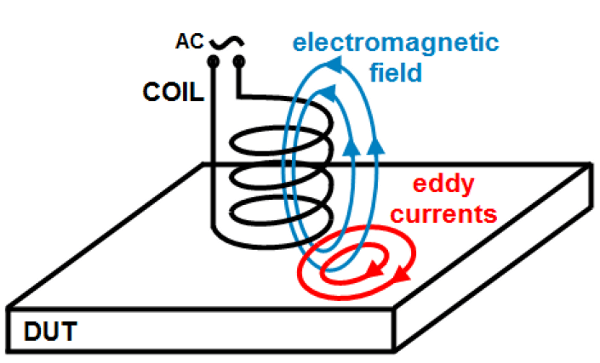
History of Eddy current testing:
As already discussed in our blog History of NDT, Most of the NDT methods were brought in industrial applications between the time period of World war I & II.
Similarly, much of the development of eddy current testing (ECT) as a nondestructive testing technique for industrial applications was carried out during World War II in Germany. Professor Friedrich Förster while working for the Kaiser-Wilhelm Institute (now the Kaiser Wilhelm Society) adapted eddy current technology to industrial use, developing instruments measuring conductivity and sorting mixed ferrous components.
Later Professor Friedrich Förster founded a company in 1948, now called the Foerster Group where he made great steps in developing practical ECT instruments and marketing them
Basic Principle:
eddy current: an electrical current caused to flow in a conductor by the time or space variation, or both, of an applied magnetic field. It’s a circulating electrical current induced in a test object by an alternating magnetic field.
The term eddy current comes from analogous currents seen in water in fluid dynamics, causing localized areas of turbulence known as eddies giving rise to vortices that occur over a prolonged period.
Lenz’s law,
named after the physicist Emil Lenz who formulated it in 1834, states that the direction of the current induced in a conductor by a changing magnetic field is such that the magnetic field created by the induced current opposes the initial changing magnetic field.
For example, if the North Pole of a magnet is facing a metal plate. the magnetic field generated from the eddy currents will be in the opposite direction of the initial changing magnetic field. Hence south pole is generated in the metal plate towards the north pole of the magnet.
It is a qualitative law that specifies the direction of induced current but states nothing about its magnitude.
Generation of Eddy current in a conductive material:
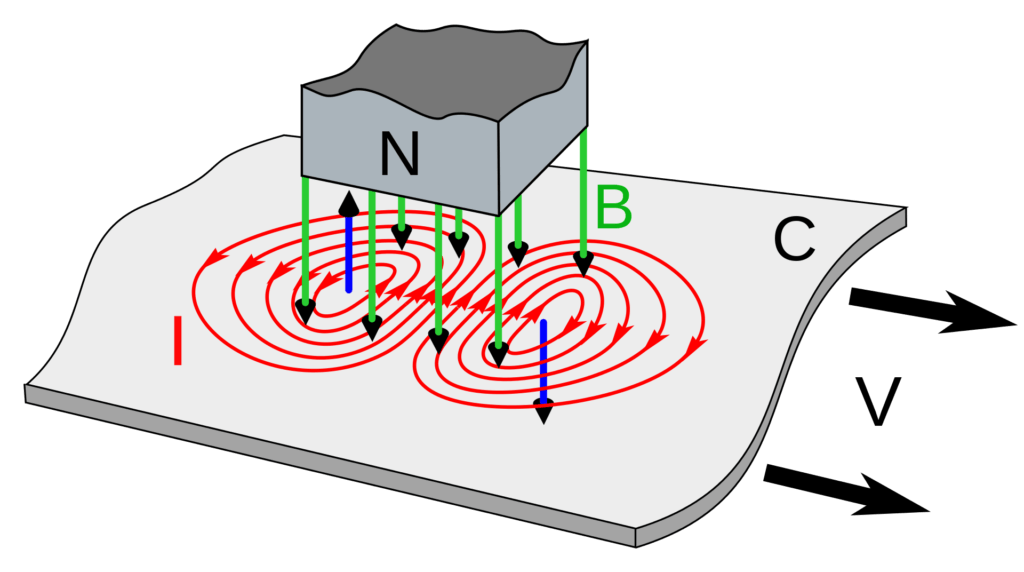
In the above figure, a conductive metal plate is in a magnetic field(B, green) of a magnet. Now when the Metal plate is moved in direction of V which causes a change in the magnetic field due to which eddy current (I, RED) is generated in the metal plate.
The increasing field at the leading edge of the magnet (left) induces a counterclockwise current, which by Lenz’s law creates its own magnetic field (left blue arrow) directed up, which opposes the magnet’s field, producing a retarding force. Similarly, at the trailing edge of the magnet (right), a clockwise current and downward counter field is created (right blue arrow) also producing a retarding force.
Elements of Eddy Current System
A basic eddy current system consist:
- Test Coil: Test coil is the basic element of Eddy Current system
- Generator: used to generate an alternating current generator driving an alternating magnetic field (primary field).
- Indicator: Meters, CRT/LCD/LED and Strip recorders are types of indicators used for eddy current testing.
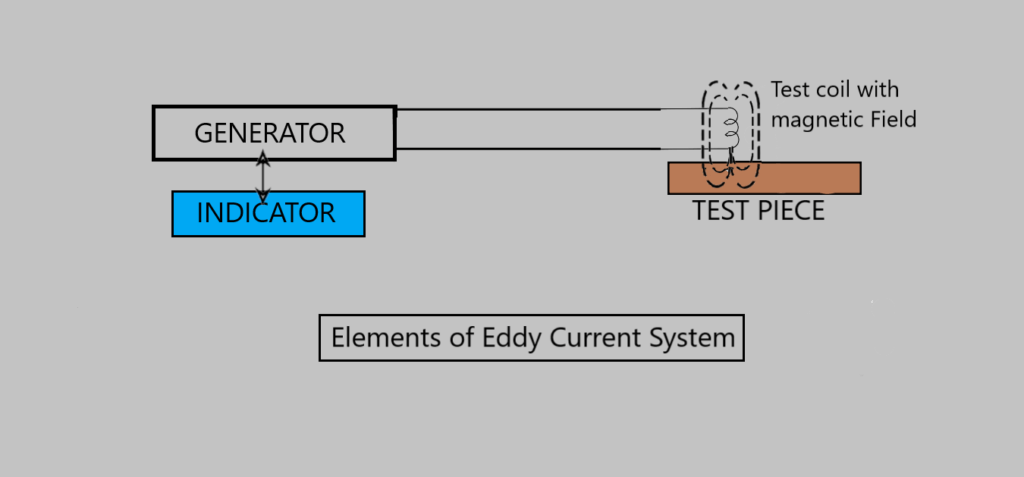
Types of Coils.

Absolute Coil: A single-coil used to measure bulk article characteristics like conductivity, dimension, permeability, etc.
Differential Coil: It consists of two coils that electrically oppose each other due to which bulk characteristics get to cancel out and small defects are observed as a difference in coils.
Surface probe: It is designed to examine the test surface. Contacting, non-contacting, operator held and automated are different types of surface probes used.
ID Probe: these probes consist of a coil that is designed to be inserted within a specific cavity configuration such as the interior of a tubing, drilled holes, etc.
OD probe or encircling probe: these probes have coils designed to be placed around the test object.
Eddy current test methods:
Conductivity testing:
most of the materials have a unique conductivity value determined by the materials chemical composition, its processing and method of manufacturing
Most pure metals like gold, copper, silver have definite conductivity values whereas most alloys have board values or ranges of conductivity.
IACS (INTERNATIONAL ANNEALED COPPER STANDARD) is a convenient method of comparing one material with another.
Sorting of materials can be carried out depending on the difference in conductivities in different materials.
Hardness measurement can be also carried out using the conductivity testing method of Eddy’s current testing. Usually, conductivity decreases as hardness increases.
Heat Treatment variations can be identified by measuring the change in the strength of the material. The strength of a material will decrease and the conductivity will increase in the direct relation to the amount of heat treatment received by the material.
Change in temperature of the test item changes the electrical conductivity this can be used to measure the temperature of the test object using eddy currents.
Discontinuity Testing:
Eddy currents flow in regular patterns within a material any discontinuity changes this pattern which can be sensed and indicated using Eddy Current system.
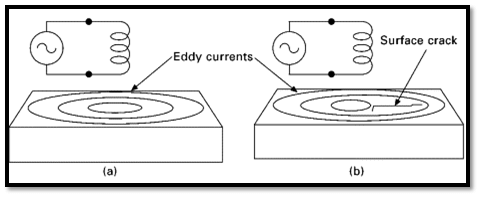
Eddy current inspection of materials (a) without and (b) with surface cracks.
Coating/plating thickness Testing:
- Conductive coating: when the coating is conductive, the conductivity of both the coating and the test item can be measured by the use of an impedance (conductivity) tester.
- Non-conductive coatings: nonconductive coating do not have eddy currents, hence lift-off effect property of the surface coil is used to measure non-conductive coating.
Industrial Application
- aerospace industry.
- petrochemical industry
- inspecting steam generator tubing in nuclear plants.
- heat exchangers tubing in power and petrochemical industries.
- inspection of partially ferromagnetic materials such as nickel alloys, duplex alloys, and thin-ferromagnetic materials such as ferritic chromium-molybdenum stainless steel.
Advantages
- High-Speed Testing.
- Accuracy.
- It can detect surface and slightly subsurface discontinuities.
- Highly Sensitive to small discontinuities.
- Accurate Thickness measurements.
- Provide Immediate indications
- Is non-contacting.
- Equipment is portable.
- Can inspect complex shapes and sizes
Limitations
- only Conductive materials can be examined
- Limited penetration in test objects
- Several variables simultaneously affect the output indication.
- Indications are qualitative, not quantitative.
- The testing of ferromagnetic materials is sometimes difficult to examine.
- A permanent record of discontinuity is often not available.
- High user Dependence
- Surface finish and surface roughness may interfere with test results
- The test surface must be accessible to the probe.
- Depth of penetration limited.
- Flaws like delaminations lie parallel to the probe coil winding and probe scan direction are undetectable
References’
- https://en.wikipedia.org/wiki/Eddy-current_testing
- https://www.sciencedirect.com/topics/chemistry/eddy-current
- Cover image: https://www.tec-science.com/material-science/material-testing/eddy-current-testing-ect/
- PTP classroom Training Handbook Eddy Current Testing.
- http://www.geocities.ws/raobpc/Probes.html
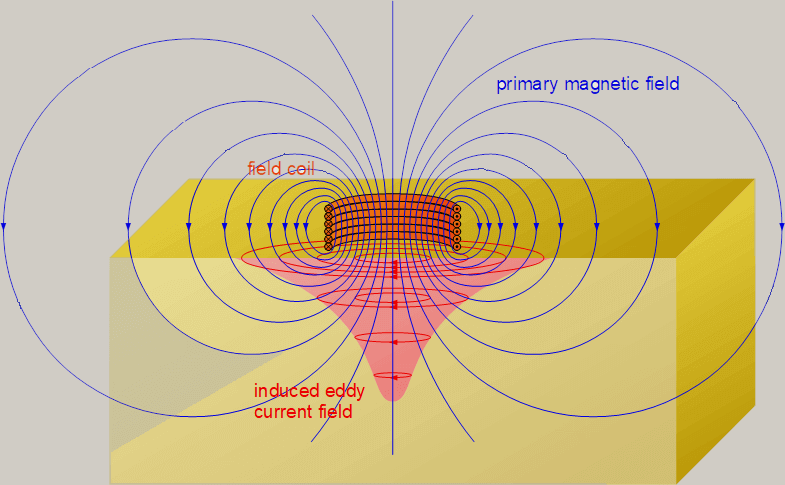
Thanks-a-mundo for the post. Much obliged.
Very intuitive, my background is with with the Eddy Current probe testing of breathing air cylinders. I would like to pursue a career in NDT testing that encompasses a wider spectrum and get on board with a decent company. After 20 years in safety, 10 as an industrial technician I’m ready to take on a new challenge.
all the best for your future endeavors.
Thanks for sharing the information with us, it was very informative or Thank you for sharing the information with us.
Thanks for such a detailed information about eddy current testing. Great content!